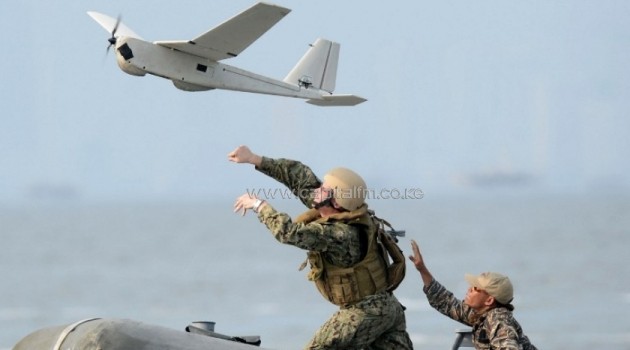
US (left) and Philippine navy personnel launch unmanned aerial vehicle (UAV) from a speed boat off the naval base in Sangley point, Cavite City, west of Manila on June 28, 2013/AFP
LONDON, February 5 – The falling cost of acquiring drones will see them increasingly used in warfare and surveillance, a leading think tank said Wednesday, although it believes citizens are unlikely to accept fully autonomous deadly attacks.
Meanwhile Asian military spending is surging ahead as European defence budgets shrink, the International Institute for Strategic Studies (IISS) said in its annual assessment of global military capabilities.
The increasing number of unmanned aerial vehicles (UAVs) and their expanding capabilities has given rise to ethical and legal arguments about their use, the IISS said in its 500-page Military Balance 2014 report.
“The proliferation and visibility of UAVs, and their use by armed forces and government agencies, has led to these platforms dominating the debate,” the London-based institute said.
It said the legal and ethical debates included whether attacks could be justified as self-defence and whether they constitute a proportional response to the combatant or otherwise status of targeted individuals.
Discussions in Western states have included reservations about the potential use of fully autonomous armed UAVs.
“Even as software-driven artificial intelligence and ‘reasoning’ systems become more advanced, machine-based decision-making as the basis for lethal action will remain a threshold legislatures and the public will likely be unwilling to cross,” the report said.
Advanced military technologies are proliferating due to lower technical barriers to entry and states’ willingness to sell them, the IISS said. One of the most sought after pieces of equipment are unmanned systems, previously seen almost exclusively in Western armed forces.
The report said the proliferation of smaller systems had reduced costs, enabling greater use by private companies, individuals and countries with limited financial resources.
UAVs have been used overwhelmingly in intelligence, surveillance and reconnaissance, in effectively uncontested airspace, it said.
However, such calculations may change if they were up against active air defence weapons. Russia and China have been developing GPS-jamming technology, the IISS said.
In ongoing trends, the report noted the relative shift towards Asia in the balance of military power, with defence budgets in the region rising as Western ones tighten.
The United States remained by far the world’s biggest defence spenders in 2013, with a budget of $600.4 million, the report said, followed by China ($112.2 million), Russia ($68.2 million) and Saudi Arabia ($59.6 million).
In terms of defence budgets as a share of gross domestic product, Afghanistan was first on 13.8 percent, followed by Oman (11.7 percent), Saudi Arabia (eight percent) and Iraq (7.2 percent).
But in real terms, Asian defence spending was 11.6 percent higher in 2013 than in 2010, with China, Japan and South Korea accounting for more than half the increases in 2013.
Total European defence spending in real terms has fallen by an average of 2.5 percent per year since 2010.
“The rapid pace of capability development and the potential for accidental conflict and escalation in Asia will continue to be a matter of concern,” the report said, citing the numerous potential flashpoints in the East Asia region.
‘Nuclear suicide mission’
For North Korea, while its ageing aircraft could not penetrate South Korean or Japanese air defences with a nuclear weapon, “a nuclear suicide mission by a mini-submarine cannot be ruled out”.
Post-Afghanistan, the NATO alliance faces pressing issues at its 2014 summit in Britain, working out what shape the “post-operational alliance” should take.
“The debate over what to do about the conflict in Syria, sharpened by the chemical weapons issue, has demonstrated that the past decade’s wars have left Western electorates at best unsure of their success or necessity,” the report said.
European militaries will likely work close together to maximise value from their defence budgets, it concluded, citing France’s operations in Mali, which are being supported by EU allies to fill in shortcomings in their capabilities.
rjm/gj/dh









































